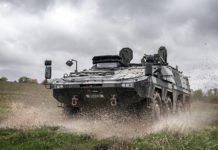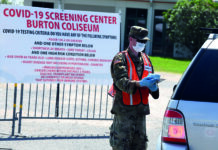The Libyan uprising followed the same pattern as the other revolutions of the Arab Spring, but it pushed the country into an opportunistic and consuming power vacuum, a vicious cycle of war, extremism, tribal competition, human rights abuses, and death. For more than a decade, Libya has been hanging between chaos and uncertainty, without any prospects for peace and stability.
12 years ago, countries in the Middle East and North Africa witnessed the first uprisings that would spread and become the Arab Spring. Marked by a common slogan – “the people want the regime to step down”, the unrest of the Arab world asked for change at any cost. But change never brought peace, stability, and democracy in the region. Instead, it pushed the region into a new vicious cycle of chaos and uncertainty, killing thousands and forcing many more to take refuge abroad. The uprising against the Libyan leader, Muammar Gaddafi, started by the same path as the other Arab uprisings, degenerating into an opportunistic and consuming power vacuum. Internal rivalries have been fuelled by further external influences of competing foreign actors that engaged in the local conflict, playing their own cards in a game that brought no gain to the Libyan people.
At the end of August 2022, The UN Security Council discussed the ongoing stalemate and continued delays in implementing the electoral process in Libya, reflected by increasing violence among rival groups and posing a growing threat to security in and around Tripoli, and potentially beyond the Libyan borders. However, it is hard to say whether there is any real interest in solving the conflict, within the country and among the foreign actors involved in the war. And this has been reflected in the evolution of the conflict since the death of Muammar Gaddafi and, at the same time, it can be easily noticed in the current context on the ground where violence has become ‘business as usual’ at the cost of the local population. While the focus of the international community has been shifted to Russia’s invasion of Ukraine and the resulting energy crisis, Libya’s cyclic civil war gets more alarming each day, threatening to affect countries of the Mediterranean and North Africa. Therefore, it is hard not to wonder what the future will bring for a country whose destiny seems to be marked by a spring that turned into a never-ending winter dictated by internal and external rivalries.
The “Libyan Spring” – a Never-Ending Winter
The Arab Spring reached Libya in February 2011, with the first uprisings starting in Benghazi, spreading to other cities across the country and leading to clashes between Gaddafi’s security forces and the opposition. In less than a month, the UN Security Council announced its decision to establish a no-fly zone over the country and airstrikes to protect civilians started under NATO’s command. In July 2011, the National Transitional Council (NTC) was formally recognised internationally as the legitimate government in the country, and the increasing anti-Gaddafi rebellions forced the former ruler to leave the capital and hide. Eight months after the first protests started, on October 20, Muammar Gaddafi was captured and killed when the opposition took control over Sirte. In the aftermath of Gaddafi’s killing, NTC declared Libya as a ‘liberated’ country and announced its plans to hold elections within eight months. 11 years have passed and the so-called ‘liberated’ country has already witnessed several rounds of civil war, paying the price for a change that never came.
There is a karmic symbolism in the killing of a leader by his own people. A symbolism that can only be noticed and understood by the ones that come from a nation who, at some point in history, turned against their leader. Videos with Gaddafi’s last moments were spread over the internet, showing a shadow of the former Libyan ruler, marked by blood, fear and hatred. Unfortunately, his death was not followed by peace, security, and stability, but, instead, the country became a perfect reflection of the ruler’s humiliating death. Violence and opportunistic extremist groups spread along the Libyan territory. In 2012, the US ambassador along with three US citizens were killed by extremist militants in Benghazi. A year later, in 2013, a blockade on oil exports was undertaken by the Petroleum Facilities Guard militia.
What started as a call for democratic change, that could provide equality, democratic rights, and a democratic elected government, turned into a civil war that was kept alive by several failed transitional governments, regional and foreign interference, hunger, and death. The North African country became divided between two rival administrations in the years after the overthrow of former leader Muammar Gaddafi a decade ago. The Government of National Accord (GNA) is based in the capital, Tripoli, located in the west, while the Libyan National Army (LNA) is in the east. Warlord Khalifa Haftar and his so-called military has attacked in several rounds Tripoli and the UN-backed, internationally-recognised Government of National Accord. Today’s failure to unify the divided Libyan nation is also rooted in the strategic policy followed by the formal regime who cemented both tribal and regional identities through selective recruitment into the security sector, causing split between East and West. This policy resulted in the form of ‘enemy’ governments based in Tripoli in the West and in Tobruk in the East, near the border with Egypt.
The ‘Libyan Spring’ turned into a never-ending winter, governed by chaos, unrest, and a geographical, political, and ideological split between East and West. Since the start of the civil war in 2014, the Libyan struggle has turned from a rudimentary conflict, marked by the typical Salafi-Jihadi nuances of the post-Arab Spring power vacuum, into a highly sophisticated multinational conflict, becoming the first totally privatised armed conflict in contemporary history. Local rivalries have been deepened by an international rivalry for the future of Libya, its people and wealth.
Libya Today
The Libyan unrest has never stopped, neither has it achieved the initial goal of a democratic country, expected to provide equality, democracy, peace, and stability. This year, the end of August brought further clashes between the two main local sides of the Libyan war, reflecting the limited political progress that was achieved. On top of this, there is still no consensus on a constitutional framework for the elections. The human rights situation in the country continues to be a concern, with reports of abuses coming in every month from several organisations active on the ground.
UN political affairs chief Rosemary DiCarlo brought to the attention of the UN Security Council that Tripoli was just recently, once again, the theatre of violent clashes between armed groups supporting either the incumbent Prime Minister, Abdul Hamid Dbeibah, or his rival Fathi Bashagha, who was appointed Prime Minister by the parliament in the east. One of the most recent violent conflicts broke out in the early hours of 27 August and rapidly intensified and spread to civilian-populated areas of Tripoli. According to UN reports, the fight involved the indiscriminate use of medium and heavy weapons, affecting civilians and civilian infrastructure. This appeared to be attempt of pro-Bashaga forces to enter the capital from the east. However, they were blocked by pro-Dbeibah forces at Zleiten – about 160 km east of Tripoli, and were forced to retreat, following clashes. Attempts by other pro-Bashagha armed groups to advance on the capital from the west and southwest were similarly repelled. The Libyan authorities released an official declaration, estimating that a total of 42 people were killed, including four civilians, while 159 were injured in the clashes. Fifty families were reportedly displaced, and five health facilities were significantly damaged. Two detention centres for migrants and refugees were affected, involving a total of 560 persons. All these numbers reflect the consequences of just one fight.
Together with the internal violent rivalry between the two main local sides of the Libyan war, the international consensus is lacking, partly due to geopolitical competition between nations such as France and Italy, each of which has a completely different way of tactical thinking when it comes to the crisis in Libya. Moreover, frequent oil production halts while lack of oil fields maintenance has cost the country billions of dollars in revenues. This year, after a three-month shut-down, oil production resumed in July, but it could close again due to public discontent in the south over lack of basic resources and poor living conditions.
In the shadow of Syria and, most recently, Ukraine, Libya’s winter is far from coming to an end. On the ground, and beyond its borders, security dynamics go hand in hand with the economic ones. Violence and chaos provide an opportunity for profitable, but short-handed political and economic gains, while the heaviest price is paid, once again, by the local population who are played as pawns by each side.
The European Crisis – a Libyan Opportunity?
Predicting the future of any country, in the current global context, is an impossible task, even if we consider history’s famous cyclicity. Many argue that the path to democracy might be different from country to country and, in the most difficult cases, it can ask for the highest price in exchange for freedom. To begin with, Libya needs a peace agreement that promotes a new system of power sharing, based on substantial decentralisation, providing the opportunity to delegate power to local participants to overcome regional rivalries. This can only be achieved by developing a complex, historical, community-based, and context-oriented understanding of the local dynamics. Unfortunately, recent global events have dispersed the interest of the international community and the active regional powers to new international crises, such as the ongoing Russia-Ukraine war, materialising further security issues.
Adopting a pragmatic and opportunistic perspective to the relation of the two separate, but equally interrelated wars, Russia’s invasion of Ukraine and the current crisis can provide a series of options for Libya. At the ground combat level, the new war in eastern Europe pushed for a migration of Russia’s affiliated mercenaries from the Libyan grounds to Ukrainian ones. While this should have represented an opportunity for the government to gain control of local militia and push for the unification of military forces, the interests of the political elite within the country fuelled further internal fighting, hindering Libya’s potential to seize the momentum.
Still, there is one more opportunity arising from the current energy crisis faced by the European countries due to the Russia-Ukraine war – the supply of hydrocarbons. Bearing in mind Libya’s high volume, proven reserves, and product quality, together with its proximity to the southern shores of Europe, the country could play a key strategic role in providing the best solution for alternative sources for crude oil and natural gas. Nevertheless, the fighting between the two interim governments, together with the public discontent in the South over a lack of basic resources, poor living conditions that cause irregular oil production, the lack of budget, and disrupted decision-making minimises the potential and reliability of Libya as a possible main energy supplier to Europe.
Lost in the rivalries of their own community leaders, paying the karmic price for the death of their formal leader, Libyans never lost their hope for a better future that will eventually bring what they have fought for ever since the first uprising in Benghazi. The US Special Envoy previously noted that holding elections is the best way out of the current political stalemate in Libya. However, holding parliamentary and presidential elections, under the current conflicts, and without a well-drafted peace agreement, is far from representing a solution to end the Libyan winter, proving once more, that we fail to understand the reality on the ground.











